Make social media applications with Flask #5: Authentication during registration and User notification
Repository
What Will I Learn?
- Authentication during registration
- User notification
Requirements
- Basic Python
- Install Python 3
- Install Flask
Resources
- Python - https://www.python.org/
- Flask - http://flask.pocoo.org/
- Peewee http://docs.peewee-orm.com/en/latest/
- Sqlitebrowser https://sqlitebrowser.org/
Difficulty
Basic
Tutorial Content
Hey everyone, I will still discuss the social media application that we made in the previous tutorial. In the previous tutorial, I created a login and base layout system. You can see the previous tutorial in the curriculum section. We have successfully retrieved user data while logged in. Now I will use the same function to connect to the register function that we have created.
User authentication registered
We have created a login system in our previous tutorial, now I will make user authentication when the user registers. I want to type when the user registers automatically the user will be authenticated as a valid user. So I will use the same function in a different place. Here's how to use:
app.py
@app.route('/register', methods =['GET', 'POST']) // Define route and methods
def registerPage():
if request.method == 'POST' and request.form['username']:
try:
with database.atomic(): // atomic methods
user = User.create(
username = request.form['username'], // key and value from user model
password = md5(request.form['password'].encode('utf-8')).hexdigest(),
email = request.form['email']
)
auth_user(user) // Do a auth when register
return redirect(url_for('showHomePage')) // redirect to the homepage
except IntegrityError:
return 'There is something error'
return render_template('register.html') // Render template
- I will run the authentication function that we have created in the
User.create()section. After we enter the data in the user model we will automatically authenticate the user to bring them in the login sectionauth_user(user).
If we do a demonstration the results will be as follows:
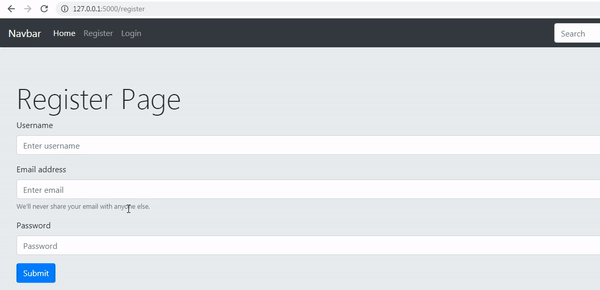.gif)
We can see in the picture above we managed to register and authenticate the user, and if we look at the database tweets.db, then we can see the user has been successfully registered and authenticated:
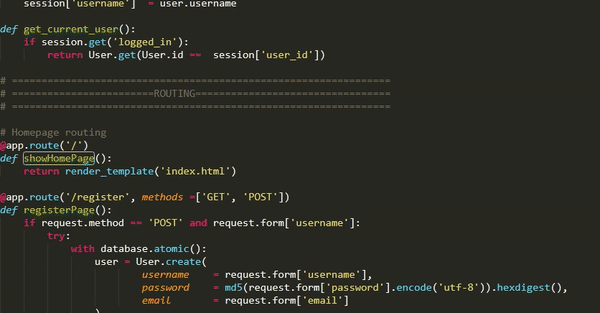.gif)
Make user notifications
To add a better response to the user, I will add a flash message when the notification appears, To add a better response to the user, I will add a flash message when the notification appears. I will add the flash function that I will use in each response. for more details, we can see in the example below:
import the flash
from flask import Flask, render_template, request, url_for, redirect, session, flash
We have used many modules that we import, one of them is flash and now we will see how to use it in the application that we have made.
Use the flash
Now I will give an example of how to use flash in the application that we have created, I will take an example when the user logs in. The function that handles authentication is auth_user().
app.py
def auth_user(user):
session['logged_in'] = True
session['user_id'] = user.id
session['username'] = user.username
flash('You have successfully logged in '+ session['username'])
After we import, we can use it using flash('You have successfully logged in '+ session['username']). Then in the frontend section I will use bootstrap to make an alert, here is how to display the flash message that we have passed in the backend.
layout.html
{% for message in get_flashed_messages() %}
<div class="alert alert-success" role="alert">
{{ message }}
</div>
{% endfor %}
We can use for to extract messages that are in the get_flashed_message () function and the value is in variable message {{ message }}.
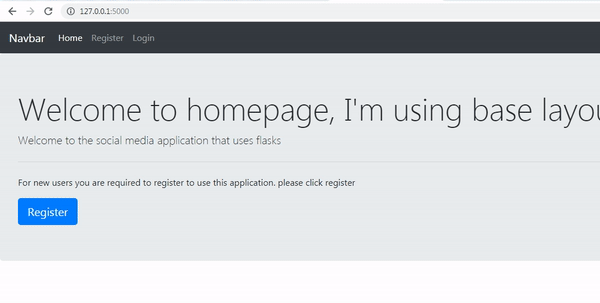.gif)
We can see in the picture above we managed to use alerts from the bootstrap to make flash messages.
Logout Function
Our authentication system is not complete, because we haven't created a system log out for our application. I will make the new routing /logout. For more details, we can see the code below:
app.py
@app.route('/logout') // Routing logout
def logout(): / define function
session.pop('logged_in', None) // Remove session
flash('logout was successful') // send flash message to frontend
return redirect(url_for('showHomePage')) // redirect to home page
I will make routing
'/logout'and use the logout functiondef logout():. to be able to delete the active session we can use thepop ().The pop function has two parameters, the first is the key from the session to be deleted, both of which we can give a default value
session.pop('logged_in', None).
And then we will apply the flash message to our logout system
View when the condition is logged out
I will make a different view when the user is on login and logout, for that I will create a new menu which is the logout list menu.
layout.html
<ul class="navbar-nav mr-auto">
<li class="nav-item active">
<a class="nav-link" href="{{url_for('showHomePage')}}">Home <span class="sr-only">(current)</span></a>
</li> // home page
<li class="nav-item">
<a class="nav-link" href="{{url_for('registerPage')}}">Register</a>
</li> // Register
<li class="nav-item">
<a class="nav-link" href="{{url_for('loginPage')}}">Login</a>
</li> // Login page
<li class="nav-item">
<a class="nav-link" href="{{url_for('logout')}}">Logout</a>
</li> // Logout
</ul>
We will see the appearance as shown below, We can see that we have done to log out when and redirect the user to the home page.
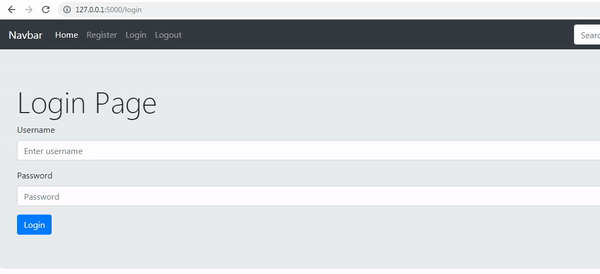.gif)
We can use the session in the frontend section to find out whether the user is logged in orlogged out. we can see a simple example like the following:
Layout.html
<ul class="navbar-nav mr-auto">
<li class="nav-item active">
<a class="nav-link" href="{{url_for('showHomePage')}}">Home <span class="sr-only">(current)</span></a>
</li>
{% if not session.logged_in %}
<li class="nav-item">
<a class="nav-link" href="{{url_for('registerPage')}}">Register</a>
</li>
<li class="nav-item">
<a class="nav-link" href="{{url_for('loginPage')}}">Login</a>
</li>
{% else %}
<li class="nav-item">
<a class="nav-link" href="{{url_for('logout')}}">Logout</a>
</li>
{% endif %}
</ul>
In the frontend we can use if not {% if not session.logged_in %} and test whether the user's session exists. The session we are testing is logged_in or not, this session is true or false. The following is the demonstration:
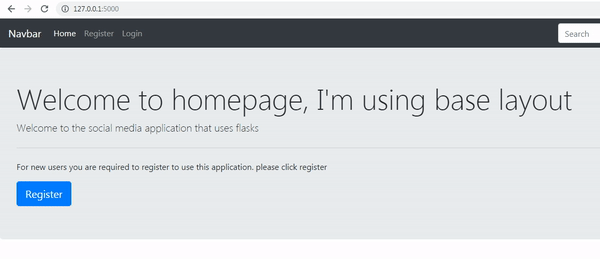.gif)
If the user is logged in, we will display the logout menu only, but if the user is logged out then we will display the register and login menu. We have worked on the authentication section of the application that we have made, in the next tutorial I will discuss more deeply the message features that we will use like social media, just my tutorial this time, thank you for following this tutorial, hopefully, it is useful.
- Web development with flask
Web developement with python #1 : Flask initialization and Routing system
Web development with python #6 : Use flash message and combine it with framework boostrap
- File in python
File in python #1 : Read file and Write file and Modes file
- Class-based views
Create Aplication social media with flask
Make social media applications with Flask #2: System routing and Templating, Make user register
Make social media applications with Flask #3: Register user and Store data in SQLite, Base Layout
Make social media applications with Flask #4: Login system and Use session to manage user data
Thank you for your contribution.
Your contribution has been evaluated according to Utopian policies and guidelines, as well as a predefined set of questions pertaining to the category.
To view those questions and the relevant answers related to your post, click here.
Need help? Chat with us on Discord.
[utopian-moderator]
Thank you for your review, @mcfarhat! Keep up the good work!
Hey @duski.harahap, great post! I enjoyed your content. Keep up the good work! It's always nice to see good content here on Steemit! :)
Posted using Partiko Android
Hi @duski.harahap!
Your post was upvoted by @steem-ua, new Steem dApp, using UserAuthority for algorithmic post curation!
Your post is eligible for our upvote, thanks to our collaboration with @utopian-io!
Feel free to join our @steem-ua Discord server
Hey, @duski.harahap!
Thanks for contributing on Utopian.
We’re already looking forward to your next contribution!
Get higher incentives and support Utopian.io!
Simply set @utopian.pay as a 5% (or higher) payout beneficiary on your contribution post (via SteemPlus or Steeditor).
Want to chat? Join us on Discord https://discord.gg/h52nFrV.
Vote for Utopian Witness!
Congratulations @duski.harahap! You have completed the following achievement on the Steem blockchain and have been rewarded with new badge(s) :
Click here to view your Board
If you no longer want to receive notifications, reply to this comment with the word
STOP